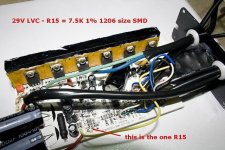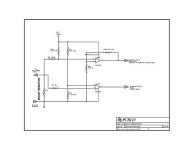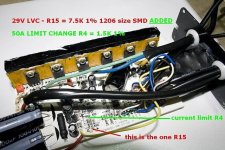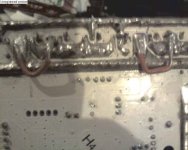rkosiorek
100 kW
and another part of the Circuit is the Power LED. it is no longer just a Power LED. it has it's own circuit board now and connects to a dedicated output pin on the Cypress controller chip.
for the power LED to turn on, the battery power must be ON and output Pin #25 on the Cypress controller has to be held High for the LED to turn on. this is for the Error codes.
View attachment 1
not 100% sure or tested but i think these are the Error Codes:
Indicator light on steady: Normal working
Indicator light on: EABS braking status
Indicator light on for 0.5 second - flash 1 time - off for 1 second: Standby status
Indicator light on for 0.5 second - flash 2 times – off for 1 second: Brake signal
Indicator light on for 0.5 second - flash 3 times – off for 1 second: MOS damage
Indicator light on for 0.5 second - flash 4 times – off for 1 second: Immediate start at high speed protection
Indicator light on for 0.5 second - flash 5 times – off for 1 second: Electric current failure
Indicator light on for 0.5 second - flash 6 times – off for 1 second: Power supply’s low voltage protection
Indicator light on for 0.5 second - flash 7 times – off for 1 second: Hall effect signal failure
Indicator light on for 0.5 second - flash 8 times – off for 1 second: No throttle signal
this circuit board is quite small and is covered in a piece of heat shrink that is glued into the endplate so the LED peeks through and is visible on the outside.
rick
for the power LED to turn on, the battery power must be ON and output Pin #25 on the Cypress controller has to be held High for the LED to turn on. this is for the Error codes.
View attachment 1
not 100% sure or tested but i think these are the Error Codes:
Indicator light on steady: Normal working
Indicator light on: EABS braking status
Indicator light on for 0.5 second - flash 1 time - off for 1 second: Standby status
Indicator light on for 0.5 second - flash 2 times – off for 1 second: Brake signal
Indicator light on for 0.5 second - flash 3 times – off for 1 second: MOS damage
Indicator light on for 0.5 second - flash 4 times – off for 1 second: Immediate start at high speed protection
Indicator light on for 0.5 second - flash 5 times – off for 1 second: Electric current failure
Indicator light on for 0.5 second - flash 6 times – off for 1 second: Power supply’s low voltage protection
Indicator light on for 0.5 second - flash 7 times – off for 1 second: Hall effect signal failure
Indicator light on for 0.5 second - flash 8 times – off for 1 second: No throttle signal
this circuit board is quite small and is covered in a piece of heat shrink that is glued into the endplate so the LED peeks through and is visible on the outside.
rick





